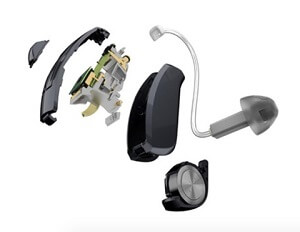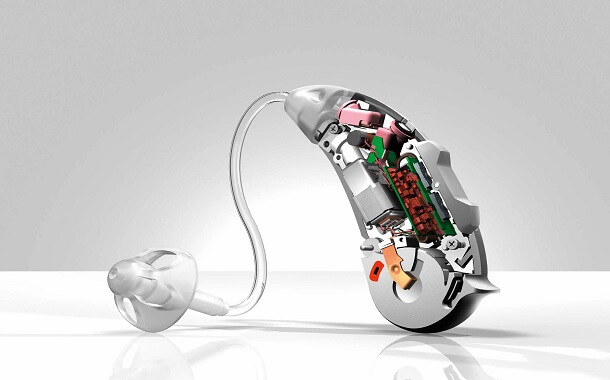Cost to Repair a Hearing Aid
Last Updated on January 25, 2023
Written by CPA Alec Pow | Content Reviewed by ![]() CFA Alexander Popinker
CFA Alexander Popinker
Hearing aids are just like most other electric devices, in that they will eventually wear out, break, or even stop working, for a more or less obvious apparent reason. Its components will eventually break due to all the years of wear, oil, and wax they have to endure, even when you care for them as well as possible and make sure they are always clean, dry, and free of damage.
Circuits can also short and their casings can break or crack. If you plan to buy a hearing aid, then you should be prepared to spend on its repair at some point or another. The final cost of repairing your hearing aid will depend on multiple factors, like whether or not it is still under warranty, the type of repair or replacement part you will need, and the model and brand of the hearing aid.
The Hearing Aid Repair Cost Depending On Warranty Status
Under the Warranty Period
Most specialists will offer one to two years of manufacturer warranty when you buy a hearing instrument from them. Although each warranty will have its own terms, which you should read thoroughly, it should include repair or replacement of any miscellaneous parts that break and most of the time, even complete replacement where needed.
Some cases will still have you pay a considerable deductible when your device is replaced, which occasionally might be a few hundred dollars, but still, it is always better to pay in the hundreds than in the thousands.
Extended Warranty and Insurance
When the warranty expires, you’ll become responsible for any costs related to the replacement or repair of your hearing aid, unless you get under an extended manufacturer warranty plan. If you consider the fact that good hearing aids should last five years or more and will need to be repaired at least a few times per year, a longer warranty isn’t actually a bad idea.
If you want to spend less, then you should know that insurance from private-party providers can be considerably cheaper than an extended manufacturer warranty. There are also some homeowner’s insurance companies that will enable you to have the hearing aid added to your existing plan.
Out-of-pocket Costs
When it comes to out-of-pocket costs, this is what you should be prepared for:
- $600-$700 for issues that need face place replacement or re-casing the external shell of your hearing aid
- $350-$500 for any mechanical issues or defects that can involve either the receiver, the microphone, or any other parts of the device
 These prices aren’t set in stone. They will usually depend on your specific brand and model and the features you get. When it comes to the casings or other important replacement parts, these can come with their own warranties, so make sure you check this especially if the same piece breaks twice in a short time span.
These prices aren’t set in stone. They will usually depend on your specific brand and model and the features you get. When it comes to the casings or other important replacement parts, these can come with their own warranties, so make sure you check this especially if the same piece breaks twice in a short time span.
You might also like our articles on the cost of the Lyric hearing aid, Miracle-Ear device, or perforated eardrum surgery.
Some hearing device specialists might tell you that a certain part, like the faceplate or the casing, is unrepairable. When this happens, take your device to an independent lab. These can usually repair even the most complex parts. Although they will still charge you for shipping your hearing aid, the price will be considerably smaller than in the case of a full replacement.
Although you might take care of your hearing aid as well as possible and have it insured or under warranty, in the end, you might still have to invest some money in their life span. And repairs are far from cheap. And although it might seem too expensive, remember that enhancing your quality of life is always worth spending on.
Specific cases when it comes to repairing your hearing aid
Your hearing aid only has minor issues
When it comes to minor issues, even if the warranty period is over, your hearing device specialist might be able to fix the instrument for cheap, if not completely free. Most minor replacements and repairs can be done in an office setting so book an appointment as soon as possible and see if you can get away with getting your hearing aid fixed for close to nothing.
Your hearing aid needs a re-casing
Although it might not seem like it, replacing the case or outer shell of the hearing aid is one of the most expensive repairs you could face when it comes to your hearing enhancement system. This alone should be at least $500 to $700 depending on the brand of the device. New cases will also come with a one-year warranty and rightly so, at such a big price, so remember to check whether the case is still under warranty or not.
Your hearing aid might have a major mechanical issue
If your hearing aid will need new parts that your specialist has to order, like parts of the electric system, it might be impossible for them to repair it in their office. This will mean that they will have to send the hearing aid to a third party for repair.
If your hearing instrument has a mechanical problem that can’t be fixed in-office, then be prepared to spend between $350 and $500 to have it repaired. This is just an estimate so take it with a grain of sand. Depending on the complexity and price of the part, it might also come with a one-year warranty.
Your hearing aid is irreparable or too old
Even if your specialist considers that your hearing aid is completely irreparable, you can still go to a third-party repair lab, but the repair will be paid from your own pocket.
If your device is older than 7 years, look into getting a new one, to take advantage of a new manufacturer warranty.
Some Common Hearing Aid Issues
According to AidAudiology, There are several issues that are more common when it comes to poor-performing or malfunctioning hearing aids:
- Physical Defects and Damage. This usually includes loose wires or a broken case from stepping on or dropping the device. There are also devices that have less noticeable issues like defective or damaged microphones, earmolds, tips, tubes, or receivers, that cause the instrument to malfunction.
- Moisture Damage. When it comes to delicate electronic components, moisture is one of the most common enemies, due to the corrosion it creates. Corrosion will likely cause reduced performance, circuit failure, and even the complete shutdown of the hearing aid.
- Accumulation of Earwax. Over 20% of hearing aid issues are a result of the buildup of earwax in their internal tubing and around delicate electronic parts, which is why most hearing aids will also have cleaning tools and wax filters.
If you have the necessary time to do so, you should clean and properly maintain your device day in and day out, to make sure that you prolong its life. It wouldn’t hurt to also learn to recognize any defects and physical damage before they turn into serious issues and are more expensive to repair. Also, try to keep your device away from moisture and eliminate any earwax buildup as soon as you notice it.


Leave a Reply
Want to join the discussion?Feel free to contribute!